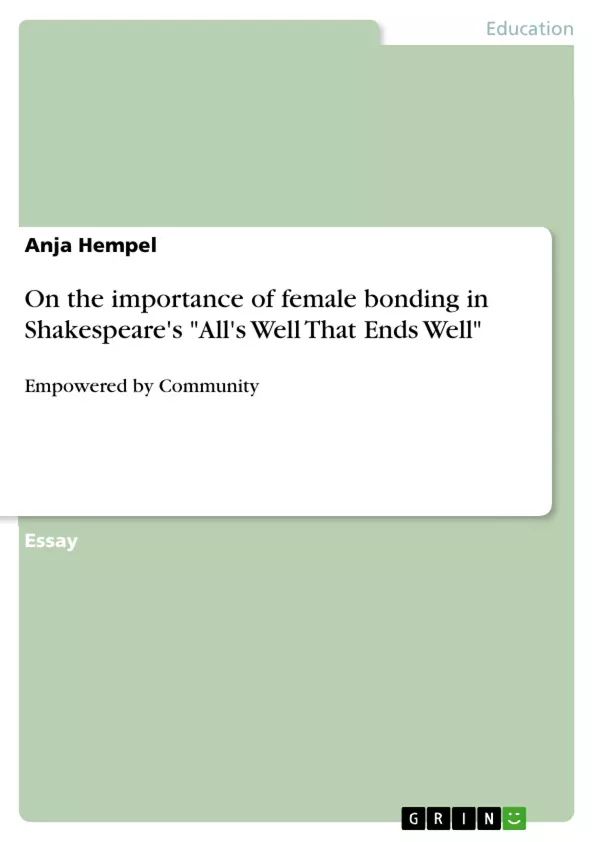In the Renaissance, the ideal of same-sex friendship between men was highly valued (cf. Kaplan 312). William Shakespeare referred to this theme in many of his literary works. In particular, his sonnets dedicated to the “Fair Lord” have provoked debates about the writer’s own sexuality. But the idea of “the other I” presented in the sonnets and included in most of Shakespeare’s plays is not limited to male friendship alone. Shakespearean drama offers many instances of affection or at least solidarity between women as well. “[J]ust as Shakespeare seems to pull free of the strictly classical dramatic forms, so too does he free himself of the purely neo-Platonic expression and uses of friendship” (Longo 8).
Feminist criticism perceives the women in Shakespeare’s plays, in particular in the comedies, as powerful and dominant (cf. Berggren 18). Often cross-dressing appears to be the strategy that allows them to break with the traditional female role comprising the in the Renaissance still prevailing “virtues of silence, obedience and chastity” (McFeely 8) . “By obscuring their own sex, the heroines gain extraordinary access to the men they love…” (Berggren 22). But besides male disguise, relationships among women give strength to each other. All in all, nineteen of Shakespeare’s plays include intimate talks between women which take place in private and refer to very personal issues (cf. McKewin 119).
In the following, I will analyse the relationships that exist among the women in Shakespeare’s problem play All’s Well That Ends Well. They can be considered particularly important, as due to the complete absence of cross-dressing in the play, they play an exceptional role in empowering the heroine. Helena “breaks out of both the cultural (historical) and psychic (transhistorical) strictures applied to women … by the assertion of desire” (Asp 75). Her determined way of wooing Bertram makes him an object and thus a reversal of traditional roles takes place. The audience experiences All’s Well That Ends Well from a female desiring perspective. That makes the play unique within Shakespeare’s canon (cf. Asp 74) and makes the careful consideration of the background allowing this changed perspective inevitable.
Inhaltsverzeichnis (Table of Contents)
- Empowered by Community - On the importance of female bonding in Shakespeare’s All's Well That Ends Well
- Introduction
- Female Bonding as a Key Element of Shakespeare's Plays
- The Mother-Daughter Relationships in All’s Well That Ends Well
- Female Solidarity as a Decisive Theme
- Conclusion
Zielsetzung und Themenschwerpunkte (Objectives and Key Themes)
This essay aims to analyze the significance of female bonding in Shakespeare’s problem play All's Well That Ends Well, arguing that it plays a crucial role in empowering the play’s heroine, Helena. The essay explores how Helena, defying traditional female roles, pursues Bertram and ultimately finds a sense of belonging and support through her relationships with other women.
- Female bonding and empowerment in Shakespeare’s plays
- The importance of female relationships in All's Well That Ends Well
- The role of mother-daughter relationships in the play
- Female solidarity and its impact on Helena's actions
- The significance of the female community in Florence
Zusammenfassung der Kapitel (Chapter Summaries)
- Introduction: This chapter sets the context by highlighting the importance of male friendship in Renaissance literature and how Shakespeare explored this theme in his sonnets and plays. It then introduces the concept of “the other I” and argues that Shakespeare's works also showcase the significance of female bonding.
- Female Bonding as a Key Element of Shakespeare's Plays: This chapter discusses feminist criticism and how it views women in Shakespeare's comedies as powerful and dominant. It analyzes the role of cross-dressing in empowering female characters and how relationships among women provide strength and support.
- The Mother-Daughter Relationships in All’s Well That Ends Well: This chapter focuses on the mother-daughter relationships depicted in All's Well That Ends Well, specifically the bond between Helena and the Countess of Rossillion. It analyzes the dynamic between them and the Countess's role as a maternal figure in Helena's life.
- Female Solidarity as a Decisive Theme: This chapter explores the theme of female solidarity in All's Well That Ends Well. It examines the interactions between Helena, Diana, the Widow Capilet, Mariana, and Violenta and how their support and compassion help empower Helena.
Schlüsselwörter (Keywords)
Key terms and concepts explored in this essay include: female bonding, empowerment, All's Well That Ends Well, Shakespearean drama, mother-daughter relationships, female solidarity, cross-dressing, feminist criticism, Renaissance literature, lovesickness, “the other I,” and “bed-trick.”
- Citar trabajo
- Anja Hempel (Autor), 2009, On the importance of female bonding in Shakespeare's "All's Well That Ends Well", Múnich, GRIN Verlag, https://www.grin.com/document/168085



